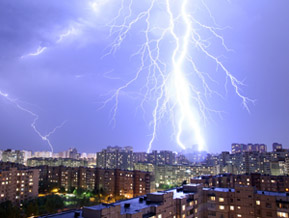Lightning 'halos' could help track fierce thunderstorms
Release Date 02 August 2013

Scientists from the University of Reading and Bristol Industrial and Research Associates Limited (BIRAL) have discovered a new method of tracking fierce thunderstorms.
The research concerns thunderstorms that produce upper atmospheric ‘halos', high altitude pancake-like electrical disturbances created from strong lightning flashes. Halos are generated by thunderstorms with lightning flashes 10 times stronger than normal¹.
Halos are too faint and short-lived to be seen with the naked eye but using images from low light cameras, they were thought to be restricted to a 50 km radius around the storm. Trial ‘electric field transient' storm detectors at the University's Observatory and BIRAL have now showed halos actually extend several hundred kilometres.
This means that distant thunderstorms producing halos could be detected much further away than the 100km expected from just using the lightning flashes alone.
This unique thunderstorm detection method also provides a much simpler way of monitoring thunderstorms producing these mysterious halos, which are still relatively new to science, 24 hours a day. The only other method of halo observation requires sensitive, high-speed video cameras, which need a clear dark sky and unobstructed view of the horizon, which are restricted to a few locations globally.
Professor Giles Harrison, from the University of Reading's Department of Meteorology and co-author of the study, said: "Lightning generated by thunderstorms regularly causes injury, damage and even fatalities in the UK, but predicting zones where lightning will strike is extremely difficult. At the moment thunderstorms are detected using the radio signals the lightning generates, which are used to identify regions of strongly disturbed weather. The new electrical approach adds information on the nature of the lightning hazard present, and how far it might extend from the storm system."
The prototype thunderstorm detectors which picked up the unusual measurements have been developed by BIRAL in collaboration with the University of Reading.
Dr Alec Bennett, from Bristol Industrial and Research Associates Limited and co-author of the study, said: "Lightning strikes can be electrically positive or negative. That means they either bring positive or negative charge down to ground, but not both. What we've observed is that the same lightning strike appears positive in Portishead but negative in Reading. That's very odd, and is the key pointer to something else going on."
The work is published in the American Physical Society's journal Physical Review Letters
ENDS
Notes to editors
¹. Due to the relatively small amount of halo research it is difficult to place a % on storms that produce halos but it is estimated that 10% of UK storms may produce at least one halo, on average.
The University of Reading is listed among the top 1% of universities in the world (THE World University Rankings 2011-12). Its Department of Meteorology is internationally renowned for its excellent teaching and research in atmospheric, oceanic and climate science. Established in 1965, Reading is the only UK university which offers a full range of undergraduate and postgraduate courses in meteorology.
The University of Reading is world-renowned for its pioneering research on weather, climate and earth observation and is also home to the Walker Institute for Climate System Research.
Biral specialises in the design, manufacture and supply of meteorological, particle analysis and biodetection instruments for science, industry , military and environmental applications. Biral is an established supplier of meteorological instruments offering one of the largest ranges of products available. The company's scope extends from sensors to measure wind, temperature, precipitation, visibility, solar radiation and other standard parameters to present weather sensors and complete weather stations.